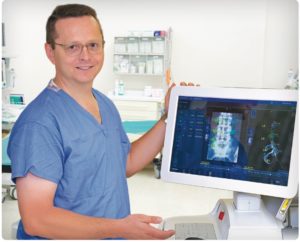Advanced Robotic System Aids Spinal Surgery | by

If you feel a twinge in your lower back while reading this magazine, you may be among the more than 31 million Americans who suffer from back pain, according to the American Chiropractic Association. Experts estimate that up to 80 percent of us will experience some type of back problem at some point in our lives. Not everyone needs surgery to fix and alleviate back problems, but some people do.
Earlier this year, orthopedic surgeon Dr. Michael Madsen and his colleagues at the Spine & Total Joint Center at Sky Ridge Medical Center began using Mazor X, the most advanced robotic technology available to treat specific back problems. Here, Dr. Madsen tells us more about this surgical advancement.

Dr. Michael Madsen uses the Mazor X’s 3D images for precise spinal surgeries.
What is Mazor X?
Dr. Madsen: Mazor X is a preoperative and intra-operative guidance and surgical system that allows surgeons to map out and perform spine surgeries – from the simple to the complex – with exact precision. Its software allows doctors to see a patient’s anatomy in 3D so we can plan and visualize surgery based on a patient’s own images. Sky Ridge began using Mazor X in February 2017 and is the only medical center within a 10-state region equipped with this state-of-the-art technology.
How does Mazor X work?
Dr. Madsen: Prior to surgery, patients undergo a computed tomography (CT) scan to capture images of their spine and surrounding anatomy. The Mazor X technology uses these images to generate a surgical plan that defines the exact locations to place surgical instruments, screws and rods. Its 3D mapping and modeling system separates the vertebrae into segments, which helps us to perform minimally invasive surgery with greater accuracy.
During surgery, surgeons guide the Mazor X robotic surgical arm to precisely place instruments and implants in the desired position based on the preoperative plan.
Who is a good candidate for this type of robotic surgery?
Dr. Madsen: There are many helpful surgical procedures that don’t involve the use of robotic technology. We evaluate every patient on a case-by-case basis to determine the best approach for a patient’s specific diagnosis. Some of the things we consider are the patient’s age and overall health, whether there’s a history of previous spine surgeries, and in the case of lumbar spinal fusion surgery, how many vertebrae need to be fused.
How does this technology help you as a surgeon?
Dr. Madsen: Surgical treatment of the spine requires planning and precision. Each surgery must be crafted around a patient’s unique challenges and anatomy. A surgeon’s view is limited during traditional open surgery. Mazor allows us to see the spine in a different way at various angles and to try new approaches before even stepping foot in the operating room. We can use the computer model to test out a surgical plan and validate that it’s the right approach. For example, sometimes we end up taking a trajectory that spares a nerve pathway. With traditional surgery, we might not have the opportunity to explore that approach or prepare for potential issues. Mazor allows for more adjustments before and during surgery that benefit the patient. And with the robotic arm, we can be more precise with the placement of instruments and implants. This results in better outcomes for the patient.
How does this robotic surgery benefit patients?
Dr. Madsen: Minimally invasive surgery causes less trauma to the body. With conventional spine surgeries, surgeons make a larger midline incision and strip muscle away from the spine in order to get a better look at the spine and access it for surgery. Robotic surgery requires two much smaller incisions on each side of the spine. The smaller openings cause less damage to muscle, nerves and skin. In addition, smaller incisions heal faster, are less prone to infection and aren’t as painful. Patients who undergo minimally invasive robotic spine surgery tend to return to everyday activities much faster than those who undergo traditional open spine surgery.
For more information or a list of surgeons, please go to skyridgespinesurgery.com.
Tags: spine surgery
Leave a Comment
Please be respectful while leaving comments. All comments are subject to removal by the moderator.
